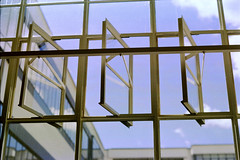MyArchitects – Walter Gropius
 For much of my collegiate career, Walter Gropius was a paragon of the architectural ideal. For me, he represented a blurring of the edges between architect, designer, teacher and philosopher that I personally found so immensely intriguing with the profession. As the catalyst behind the Bauhaus school, and certainly one of the fathers who gave birth to the morphology of modernism, Gropius’ work personifies everything that is elegant about contemporary design.
For much of my collegiate career, Walter Gropius was a paragon of the architectural ideal. For me, he represented a blurring of the edges between architect, designer, teacher and philosopher that I personally found so immensely intriguing with the profession. As the catalyst behind the Bauhaus school, and certainly one of the fathers who gave birth to the morphology of modernism, Gropius’ work personifies everything that is elegant about contemporary design.
While I had seen many of his works during and after the war, is wasn’t until I was introduced to his 1922 submission for the Chicago Tribune Tower Competition that whole new worlds opened for me. His entry, at a time less than a handful of years removed from the First World War, severed this association with the past (much as the war hearkened the end of the old world) not only incorporated his modern elegance, but suggesting a level of futuristic advancement few others, I believe, had begun to consider.
This tower was everything that others would not achieve for thirty years. While some architects of the period were on that edge, thinking in new terms, with new tools, and new shapes, this work was one of the few I saw as a gateway into how one can use architecture not just as a revolution in construction or shelter, but as a way to shape the future.
As a result, I subsequently returned to his earlier work in greater detail. While yes, it was innovative, and yes it redefined the profession, it always had a balanced elegance to it that I found engaging. Not as spartan as Loos, not as rigorous as Le Corbusier, instead preserving a particular regal sense of hierarchy that is distinctly “old world” but with a vocabulary which shown fresh and new while appropriately corresponding to the industrial age. Much like Sullivan used the traditional tripartite arrangement of classical design, reformulated and reformatted to server a more modern typology, Gropius’s early forms spoke a new language, but in coherent ways. The movement and interactive nature of the Bauhaus curtain wall, the proud stance of the Fagus Factory, elegant creatures of the machine age both, but still respectful of their heritage.
I think it is important to understand the past and be respectful of it in design, especially when a designer chooses to diverge from that past. Similar to an Italian Mannerist, Gropius understood the rules before making a conscious and deliberately calculated push to break them.






